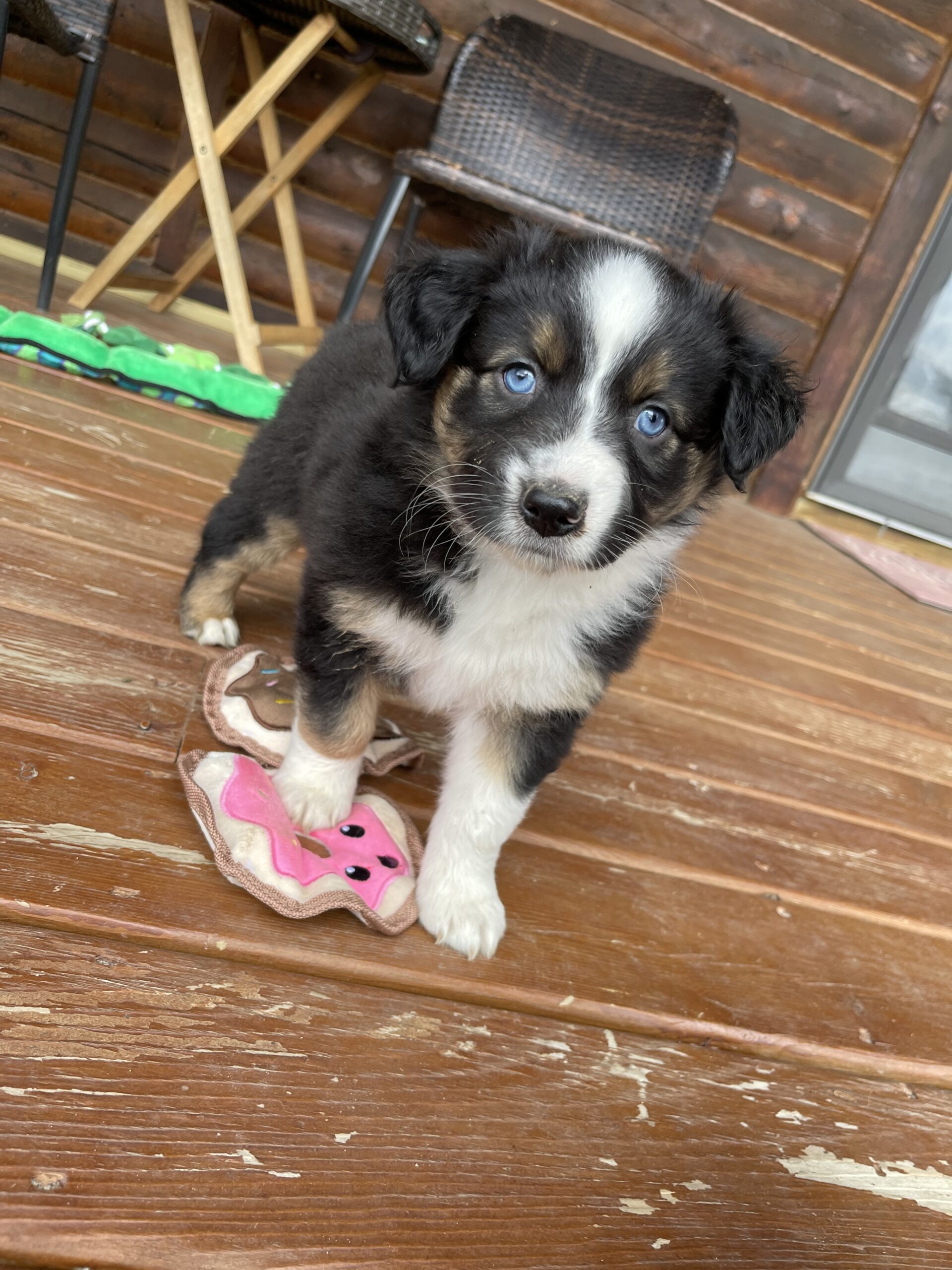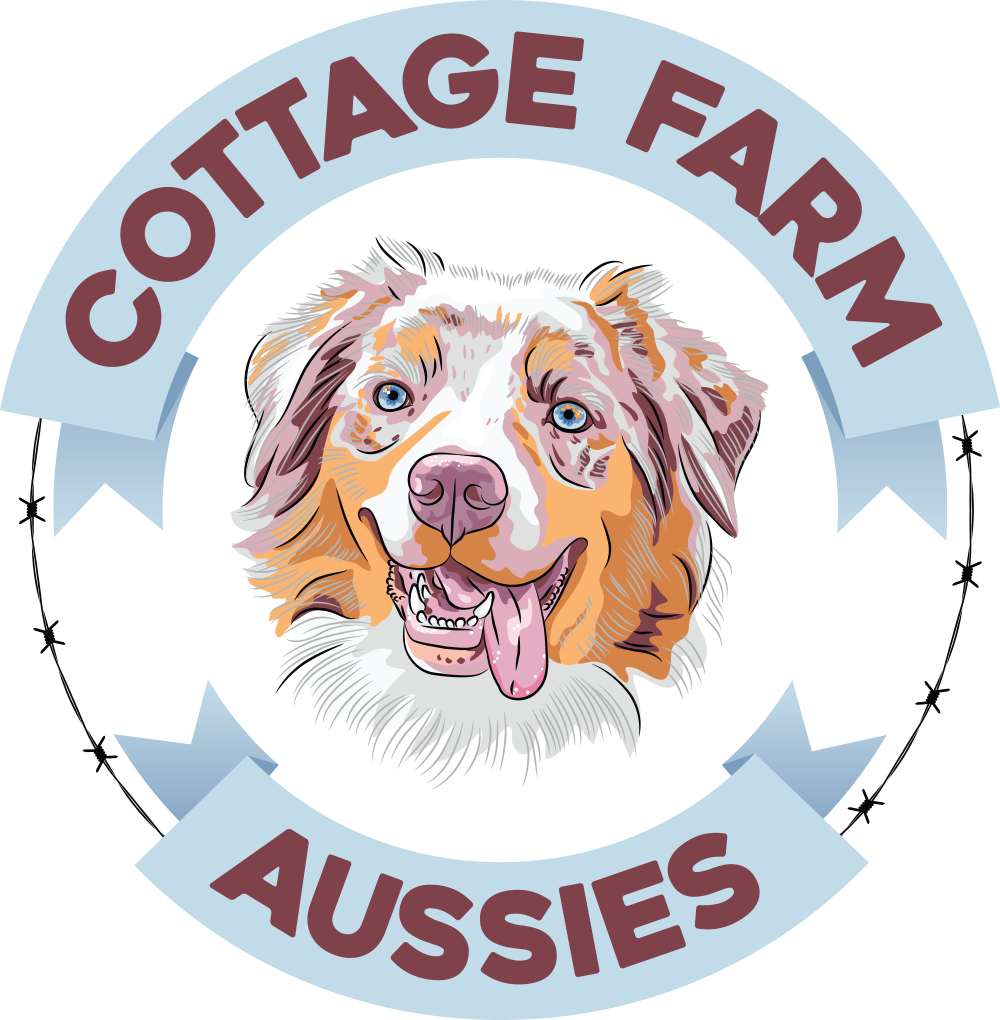Welcome to Cottage Farm Aussies!
Preparing for Your New Puppy
Prepare for Bringing the Puppy Home
Of course, you’re excited and eager to start life with your new pet. Now try to imagine what this is like for the puppy. He’s just been taken from his mother, siblings, the only humans he knows, and his familiar environment. Therefore, it’s up to you to prepare as well as you can to make the transition as easy as possible, for you and the puppy.
Puppy-proof
Like toddlers, puppies can get themselves in a lot of trouble very fast. You’ll want to protect your dog (and your home) from potential trouble spots. Use our handy puppy-proofing checklist to get everything in order before beginning the puppy home.
Gather supplies
Buy or borrow a crate. A dog crate provides a secure place for a puppy to rest and sleep. It also acts as a safe place should you need to leave him alone for brief periods. A crate can prove useful in housebreaking because a dog won’t soil his crate unless the owner fails to take him outside to relieve himself. The crate should be large enough to allow the dog to stand in it and turn around.
If you’re planning on limiting the puppy’s access to parts of the house or to certain rooms, buy or borrow baby gates. Since this is probably temporary, consider gates that use tension to attach to the walls.
A collar and leash are essential. Your puppy will love to go for walks outdoors and you will need to be in control. Of course, your puppy can go off-leash in a safe area, such as an enclosed backyard. A leash is also needed when training your dog to obey basic commands.
Buy food and water bowls…and food. A typical puppy should be fed two to three times a day. Consult your breeder or a veterinarian about your puppy’s diet. He might need a special food for allergies or weight management. You’ll also need a good supply of healthy treats, which will come in handy when you begin to train your puppy.
Whether in a crate or out and about, your puppy will need his own dog bed. Soon enough he’ll learn that this is his special sleeping and napping spot. There are probably as many dog bed styles as there are mattress options for humans, so you should have no trouble finding something suitable.
Buy grooming supplies. Your choice of long-hair or short-hair breed will dictate the types of brushes and combs you might need. Dog shampoo and conditioner, cotton balls or gauze for ear cleaning, nail clippers, and dog toothpaste and toothbrush are also items to add to your shopping cart.
Face it, you’ll need supplies to clean up puppy accidents. Stock up on paper towels, cleaning cloths, and commercial cleaners designed to clean up typical dog messes.
Don’t forget the fun stuff, toys! Your new puppy will be curious and active, and toys are an excellent outlet. Hard rubber toys, rope toys, and flavored synthetic bones are particularly good for unsupervised play. Soft-stuffed toys and tennis balls are fine, as long as you keep an eye on your puppy. A determined puppy can tear into a soft toy or a tennis ball and might swallow pieces. The AKC shop has some toy packages specifically designed for puppies,
Decide on the house rules
Most puppies are eager learners, but they’re not going to learn if the rules change every minute, if one day they’re allowed on the furniture and the next day they’re not. Or if you think his nipping at you today is cute, but tomorrow decide it’s annoying. The most important points are consensus and consistency, so the whole household should sit down together to come up with the house rules for your new puppy.
Introduce the Puppy to His New Home and Family
As excited as you are, you’ll make the puppy’s transition easier if you start slowly. Introduce family members one at a time, if possible, and give your new pet time to explore his surroundings. Show him his sleeping spot, outdoor potty place, crate, and water and food bowls. Most fun of all, introduce him to his toys. During these first few days and weeks, keep an eye on your puppy at all times and make sure that he’s supervised or, at the very least, in view.
Now’s also the time to decide which family member is responsible for what: who will do the last night potty walk, who will feed him, who’s job is it to clean up accidents, etc. You might want to create a schedule for feedings, potty, and walks, which will also serve as a helpful reminder when it comes to everyone’s responsibilities.
It’s never too early to start reinforcing good behavior with treats and rewards and to gently correct undesirable behavior. But keep in mind that puppies chew, they piddle, they cry, and they can unwittingly put themselves in harm’s way, With attention, supervision, rewards, and time spent together, you’re creating a bond that lasts a lifetime.
Be Vigilant About Your Puppy’s Health
- Set up regular appointments with your veterinarian for checkups.
- Be sure to follow the schedule of vaccinations. Puppies do get some antibodies from their mothers, but vaccinations and follow-up boosters are essential to protect him from serious diseases.
- Your vet will probably recommend preventative steps you can take for diseases like Lyme Disease and heartworm. These are usually topical repellents for fleas and ticks and chewables to protect against heartworm. Help yourself remember when to apply by adding this to your calendar.
- Learn the health risks that are specific to his breed. Your vet will advise you on how to prevent them and to recognize the onset of any diseases or conditions.
Here’s a quick daily checklist that will help you maintain your puppy’s good health:
- Check his skin and coat by running your hands over him. Check for ticks, fleas, other insects, and, in general, anything that’s not supposed to be there.
- Notice if he’s scratching or rubbing his ears excessively.
- Check his paws for cuts or abrasions.
- His eyes should be clear, with no discharge or redness.
- Look at his feces for anything undigested or for a change in consistency or frequency.
- Many symptoms of illness could be something serious or just a minor upset. As a general rule of thumb, the following should be monitored and, to be safe, checked by your vet:
- Diarrhea
- Vomiting
- Unusual tiredness or lethargy
- Any discharges from eyes or nose
- Fever
- An extreme change in feeding, such as loss of appetite
Along with the joy of owning a puppy comes the responsibility for his health and well-being. Taking a few minutes each day to check your puppy’s health should be part of your daily routine and can save a lot of heartache down the road.
Find more information about your puppy’s first vet visits and the canine vaccinations your pup needs.
If this all sounds like a lot of work, it is! Your new pup is in a new place with a new “pack” and it’s your job to ease him in. But it’s also fun, exhilarating, and immensely rewarding to care for this young addition to your family.
The AKC has lots of puppy information to guide you on your way.
Source: Reisen, Jan. "Preparing for a New Puppy." The American Kennel Club, 26 Aug. 2020, www.akc.org/expert-advice/home-living/preparing-new-puppy/. Accessed 14 Mar. 2023.


